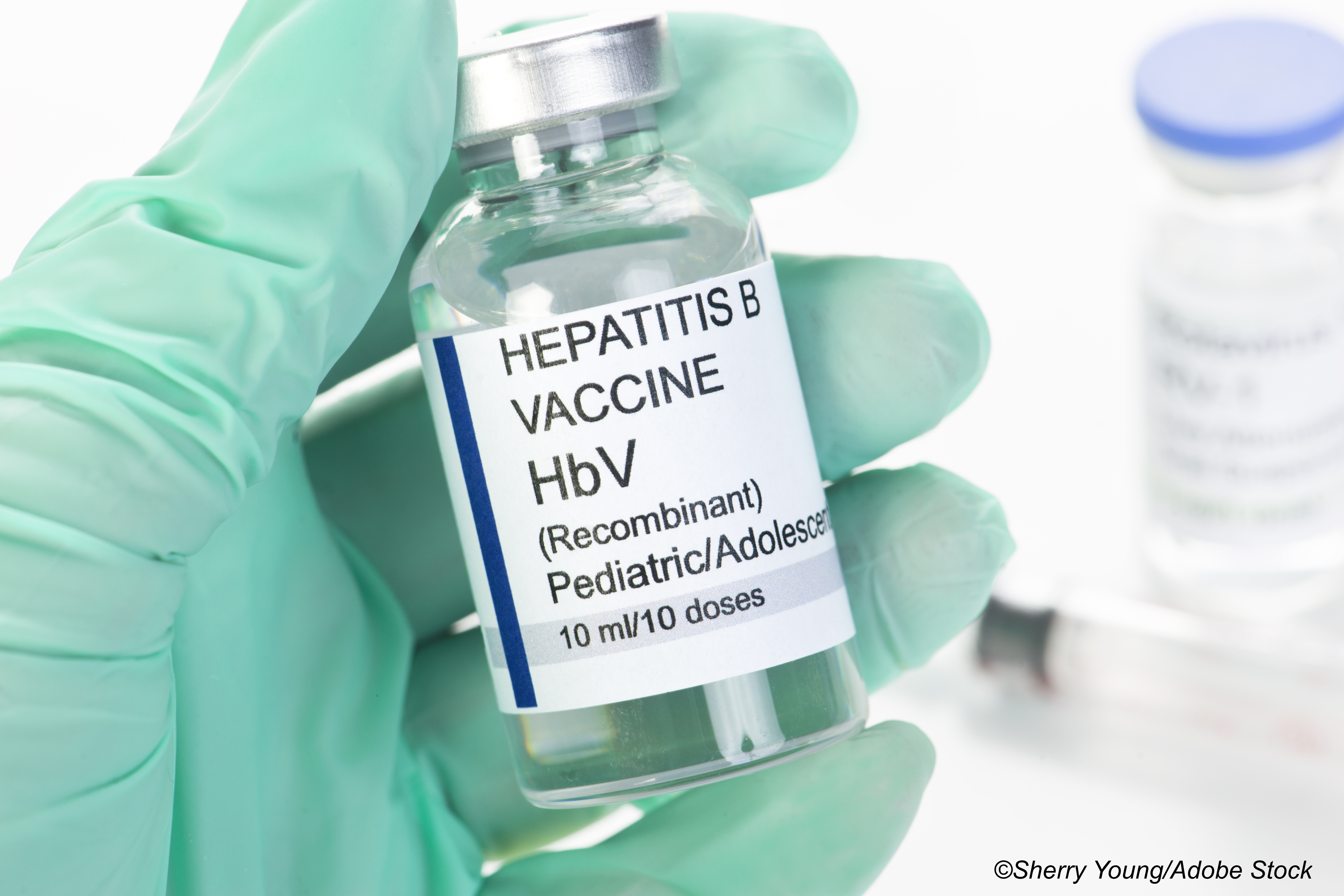
A new triple-antigen (3A) vaccine against the hepatitis B virus (HBV) offers noninferior protection compared with the currently approved single-antigen HBV (1A-HBV) vaccine, according to results from a phase III, double-blind, randomized study. In fact, the 3A-HBV vaccine given to young healthy adults achieved higher seroprotection rates (SPRs) after two and three doses compared with the 1A-HBV vaccine.
“Limitations with single-antigen (1A), yeast-derived HBV vaccines include prolonged time to achieve seroprotection, given that only 30% to 40% of adults are seroprotected after 2 doses. At least 10% of all adults fail to achieve seroprotection after a 3-dose schedule and are considered nonresponders to HBV vaccination. The proportion of adult nonresponders is higher in individuals 30 years or older, among whom there is a well-documented age-dependent decline in response rate to conventional single-antigen vaccines (1A-HBV) such as Engerix-B8-12 with seroprotection rates (SPRs) in adults falling to less than 75% after age 40 years,” wrote Timo Vesikari, MD, of the Nordic Research Network Ltd, Tampere, Finland, and fellow CONSTANT researchers.
They published their results in JAMA Network Open.
“Supported by clinical studies that reinforced its safety and efficacy in neonates, children, and adults, 3A-HBV received marketing authorization in Israel in 2000. In this study, we aimed to demonstrate the consistency of 3 consecutively manufactured lots of 3A-HBV in terms of antibody response 4 weeks after completion of the 3-dose regimen and the noninferiority of seroprotection achieved with 3A-HBV vs 1A-HBV to support regulatory approval of 3A-HBV in North America and Europe,” they added.
“The 3A-HBV vaccine is a recombinant, 3-antigen vaccine that has shown, in clinical trials, to induce high antibody concentrations resulting in high SPRs against HBV, which can cause a lifelong chronic infection with a high risk of liver fibrosis, cirrhosis, and hepatocellular carcinoma if left untreated. The 3A-HBV vaccine has been shown to achieve high SPRs and induce anti-HBs concentrations across diverse healthy adult populations in Asia, Europe, and North America and also in key subgroups of older adults with poor or delayed responses to standard-of-care HBV vaccines,” Vesikari and colleagues explained.
A 3A-HBV vaccine candidate is currently under FDA regulatory review for marketing approval in both the U.S. and Europe.
In the CONSTANT study, conducted at 37 community clinics and academic hospitals in Canada, Europe, the U.K., and the U.S., Vesikari et al sought to assess the manufacturing equivalence of a 3A-HBV vaccine (10 μg), assess the noninferiority of its SPR compared with a 1A-HBV vaccine (20 μg) after two and three doses, and compare the safety and reactogenicity of both. They defined seroprotection as “attainging an anti-HBs concentration of at least 10 mIU/mL.
They randomized 2,838 healthy young adults (mean age: 33.5 years; 57.8% women; 91.5% White, 5.7% Black or African American) to one of three 3A-HBV vaccine groups or a 1A-HBV vaccine (control) and followed them for 48 weeks after initial vaccination. The main outcome was the geometric mean concentration (GMC) of serum hepatitis B surface antibodies (anti-HBs) and the number of patients who achieved seroprotection.
Lot-to-lot consistency was seen with the three doses of the 3A-HBV vaccine, and the SPR of the pooled 3A-HBV vaccines were noninferior to the 1A-HBV vaccine. After two vaccinations the SPRs of the pooled 3A-HBV vaccines were higher compared with the 1A-HBV vaccine, at 90.4% on day 168 (95% CI: 89.0%-91.8%) compared with 51.6% (95% CI: 47.5%-55.6%), respectively. The same was true after three vaccinations, with SPRs of 99.3% on day 196 (95% CI: 98.7%-99.6%) compared with 94.8% (95% CI: 92.7%-96.4%).
Further, Vesikari et al found that the mean anti-HB GMC with 3A-HBV vaccination was 7.9 times higher after two vaccinations and 3.5 times higher after three vaccinations compared with those of the 1A-HBV vaccine as follows:
- After two vaccinations, the GMC of 3A-HBV was 118.7 mIU/mL (95% CI: 108.0-129.0 mIU/mL; SE, 1.0 mIU/mL) compared with 15.0 mIU/mL (95% CI: 12.9-17.5 mIU/mL; SE, 1.0 mIU/mL) for the 1A-HBV vaccine.
- After three vaccinations, the respective GMC were 5,442.4 mIU/mL (95% CI: 4967.0-5963.0 mIU/mL; SE, 1.0 mIU/mL) compared with 1,567.2 mIU/mL (95% CI: 1338.0-1834.0 mIU/mL; SE, 1.0 mIU/mL).
Both local and systemic reactogenicity rates were higher with the 3A-HBV vaccines compared with the 1A-HBV vaccine (local: 85.0% versus 65.9%, respectively; systemic: 68.0% versus 60.1%).
Vesikari and colleagues also noted that both vaccine discontinuation due to adverse events and serious adverse events were uncommon, with the latter occurring in only 2.0% of patients in the 3A-HBV groups and in 0.4% of those in the 1A-HBV group.
“This study demonstrated robust, consistent, and strong humoral response induced after 2 and 3 doses of 3A-HBV, thus establishing consistency of the 3A-HBV lots tested. We also demonstrated noninferiority based on the SPR of 3A-HBV compared with 1A-HBV 4 weeks after the third dose. The 3A-HBV vaccine was highly immunogenic in young healthy adults, with higher SPRs after 2 and 3 doses compared with 1A-HBV. The rapid induction of protective antibody levels in more than 90% of participants after 2 doses of 3A-HBV and prior to the third vaccination was a significant finding. The good safety profile of 3A-HBV supports its use in young adults and those at risk of infection who may require accelerated seroprotection,” concluded Vesikari and fellow researchers.
Study limitations include the use of seroprotection as a surrogate for clinical protection against HBV infection, “although it is a widely accepted correlate of immune protection,” they noted.
-
The 3A-HBV vaccine was highly immunogenic in young healthy adults, with higher seroprotection rates (SPRs) after second and third doses compared with 1A-HBV.
-
The 3A-HBV vaccine’s good safety profile supports its use in young adults and those at risk of infection who may require accelerated seroprotection.
Liz Meszaros, Deputy Managing Editor, BreakingMED™
Funding for this research was provided by VBI Vaccines Inc.
Vesikari reported being the majority shareholder of Nordic Research Network Oy.
Cat ID: 125
Topic ID: 79,125,730,125,190,31,44,192,561,925


